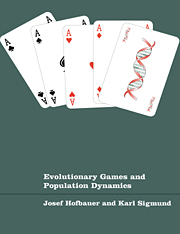Book contents
- Frontmatter
- Contents
- Preface
- Introduction for game theorists
- Introduction for biologists
- About this book
- Part one Dynamical Systems and Lotka–Volterra Equations
- Part two Game Dynamics and Replicator Equations
- Part three Permanence and Stability
- Part four Population Genetics and Game Dynamics
- 18 Discrete dynamical systems in population genetics
- 19 Continuous selection dynamics
- 20 Mutation and recombination
- 21 Fertility selection
- 22 Game dynamics for Mendelian populations
- References
- Index
18 - Discrete dynamical systems in population genetics
Published online by Cambridge University Press: 05 June 2012
- Frontmatter
- Contents
- Preface
- Introduction for game theorists
- Introduction for biologists
- About this book
- Part one Dynamical Systems and Lotka–Volterra Equations
- Part two Game Dynamics and Replicator Equations
- Part three Permanence and Stability
- Part four Population Genetics and Game Dynamics
- 18 Discrete dynamical systems in population genetics
- 19 Continuous selection dynamics
- 20 Mutation and recombination
- 21 Fertility selection
- 22 Game dynamics for Mendelian populations
- References
- Index
Summary
We discuss the Hardy–Weinberg law of population genetics and derive the discrete selection model which describes the evolution of gene frequencies if genotypes have different survival probabilities and generations do not overlap. The fundamental result, here, is that the average fitness never decreases. This result is no longer valid if mutation or recombination terms are included.
Genotypes
The cells of higher organisms may present very different aspects, depending on the type of tissue. Apart from a few exceptions, however, they all contain a nucleus where the genetic program is stored in the form of chromosomes. The number of chromosomes varies with the species (there are 46 of them in our cells), but they always occur in homologous pairs. If such a diploid cell divides, each chromosome duplicates, and the two daughter cells each receive a complete set of chromosomes.
Our organism also contains haploid cells having only half the number of chromosomes, one from each pair. These are the germ cells or gametes (sperms and eggs). Such cells issue from diploid cells by the process of meiosis, which splits the chromosomal pairs. Different pairs of chromosomes split up independently of each other. At mating, pairs of gametes fuse, thereby restoring the full number of chromosomes. The newly formed diploid cell, called a zygote, is the starting point of a new organism, which inherits half of its genome from each parent.
Information
- Type
- Chapter
- Information
- Evolutionary Games and Population Dynamics , pp. 235 - 248Publisher: Cambridge University PressPrint publication year: 1998
